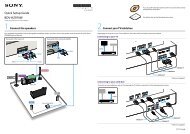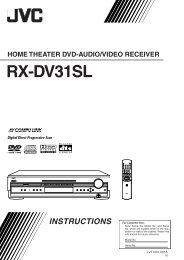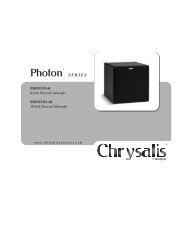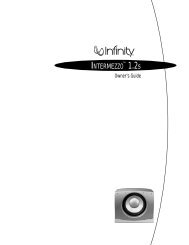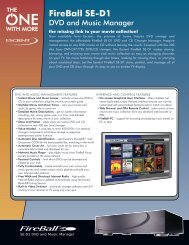athena TECHNOLOGIES ® Point 5 System Review ... - One Call
athena TECHNOLOGIES ® Point 5 System Review ... - One Call
athena TECHNOLOGIES ® Point 5 System Review ... - One Call
You also want an ePaper? Increase the reach of your titles
YUMPU automatically turns print PDFs into web optimized ePapers that Google loves.
SATELLITE RADIO ROAD TEST: XM vs. SIRIUS<br />
REPRINTED FROM<br />
4 Players for<br />
$200 or Less<br />
Sony’s Web-Savvy<br />
Camcorder<br />
Upscale Receivers<br />
From Yamaha,<br />
Denon, and Integra<br />
Hidden DVD<br />
Treasures Revealed<br />
Home Recording Tips<br />
<strong>Review</strong>ed<br />
● Pioneer Widescreen HDTV<br />
● M&K and Athena Speakers<br />
● Panasonic’s $400 Receiver<br />
JULY/AUGUST 2002<br />
www.soundandvisionmag.com<br />
AOL Keyword: Sound & Vision<br />
<strong>athena</strong> <strong>TECHNOLOGIES</strong> <strong>®</strong> <strong>athena</strong> <strong>TECHNOLOGIES</strong> <strong>Point</strong> 5 <strong>System</strong> <strong>Review</strong><br />
<strong>®</strong> <strong>Point</strong> 5 <strong>System</strong> <strong>Review</strong><br />
PAR008E<br />
“The <strong>athena</strong> <strong>athena</strong> <strong>Point</strong> <strong>Point</strong> 5 5 <strong>System</strong>s <strong>System</strong>s delivers delivers olympian olympian sound sound at at a a very mortal mortal price.”<br />
price.”
Greek mythology holds that Athena,<br />
PHOTOS BY TONY CORDOZA<br />
test report BY RICH WARREN<br />
Athena<br />
<strong>Point</strong> 5 Home Theater Speaker <strong>System</strong><br />
goddess of wisdom, sprang fully<br />
formed from the head of Zeus, king<br />
of the gods. In this case, Athena<br />
Technologies, maker of this <strong>Point</strong><br />
5 system, leapt fully developed<br />
from Audio Products International, the<br />
parent of notable speaker brands Energy<br />
and Mirage.<br />
Except for size, the <strong>Point</strong> 5 resembles a<br />
conventional subwoofer/satellite system.<br />
Where the satellites in most such systems<br />
are about the width and height of a paperback<br />
epic, the magnetically shielded S.5<br />
satellites are closer to the size of a hardbound<br />
novel, and the full-size C.5 center<br />
speaker might not even fit atop a small TV.<br />
On the other hand, the P.5 powered subwoofer<br />
is slightly smaller than the norm,<br />
and Athena suggests placing it at least a<br />
few inches away from walls since it has a<br />
down-firing driver (little feet keep it off the<br />
floor) and a front-firing port.<br />
When you buy the <strong>Point</strong> 5 system, you<br />
have a couple of finish options. The S.5<br />
fast facts<br />
satellites come with cherry woodgrain vinyl<br />
or high-gloss black cabinets, black or<br />
silver baffles, and gray cloth grilles. The<br />
subwoofer has front-mounted controls and<br />
is finished in basic black vinyl with knit<br />
cloth side panels. All six speakers have<br />
large, sturdy binding posts that are set too<br />
far apart for dual banana plugs.<br />
The S.5 enclosures have an unusually<br />
large, deep port in back that extends almost<br />
all the way inside to the tweeter. Below<br />
that is a large slotted bulge that accepts a<br />
supplied wall-mounting bracket that lets<br />
you aim the speaker either horizontally or<br />
vertically; the bulge keeps the port away<br />
from the wall. Athena also offers ST.5<br />
stands ($89 a pair), waist-high hollow tubes<br />
that ideally should be filled with sand. They<br />
have massive bases and small mounting<br />
plates on top; screws hold the speakers<br />
onto the plates.<br />
The subwoofer has a couple of unusual<br />
switches. The first is a mode switch that selects<br />
between S.5 and SUB. Select the S.5<br />
position, and the sub automatically sets the<br />
S.5 C.5 P.5<br />
(L/R satellites) (center) (subwoofer)<br />
TWEETER 1-inch dome 1-inch dome —<br />
MIDRANGE 4-inch cone two 4-inch cones —<br />
WOOFER — — 8-inch cone<br />
ENCLOSURE ported ported ported<br />
POWER — — 75 watts<br />
INPUTS gold-plated gold-plated speaker-level binding<br />
binding posts binding posts posts, line-level RCA<br />
DIMENSIONS 5 3 ⁄ 4 x 8 1 ⁄ 2 x 6 1 ⁄ 4 15 x 5 5 ⁄ 8 x 6 1 ⁄ 4 10 x 13 1 ⁄ 4 x 13 1 ⁄ 2<br />
(WxHxD) inches inches inches<br />
WEIGHT 6 pounds 9 1 ⁄ 2 pounds 15 pounds<br />
FINISH high-gloss black with high-gloss black with black vinyl, black<br />
silver or black baffle silver or black baffle; cloth side panels<br />
or cherry with black dark gray cloth grille<br />
baffle; dark gray<br />
cloth grille<br />
PRICE $175 a pair $175 each $275 each<br />
Total: $800<br />
MANUFACTURER Athena Technologies, Dept. S&V, 3642 McNicoll Ave., Toronto, Ontario<br />
M1X 1G5; www.<strong>athena</strong>speakers.com; 416-321-1800
test report<br />
The Athena speakers realistically conveyed the subtle<br />
sound effects and dialogue in The Contender.<br />
optimal crossover and a preset equalization<br />
curve for the <strong>Point</strong> 5 system, bypassing the<br />
Bass Range control. The Bass Level control<br />
remains functional. The SUB position<br />
is for use with other satellite speakers. The<br />
second switch lets you select Audio or Video<br />
playback. Audio is said to provide a flat<br />
frequency response for music playback;<br />
the Video position boosts the bass for movie<br />
soundtracks. You can connect the P.5 using<br />
either a line-level signal from your receiver<br />
or processor’s subwoofer/LFE (lowfrequency-effects)<br />
output or speaker-level<br />
signals from the left/right front-channel<br />
outputs. I chose the former hookup.<br />
Athena’s 31-page manual devotes three<br />
pages of text to each of a multitude of languages,<br />
leaving the setup diagrams for the<br />
last three pages. Only in<br />
the diagrams will you find<br />
the recommended Dolby<br />
Digital bass-management<br />
settings, and it would be<br />
easy to overlook them, as<br />
I did initially. But it would<br />
be a great mistake because<br />
unlike many other<br />
sub/sat systems, the <strong>Point</strong><br />
5 is designed to give best<br />
results when you set all<br />
the main-channel speakers<br />
to “large.” The manual<br />
does not suggest where to<br />
set the crossover frequency<br />
for the subwoofer/LFE<br />
output, so I consulted an<br />
Athena product manager,<br />
who suggested 120 Hz.<br />
I set up the <strong>Point</strong> 5 system<br />
in my 10 x 12-foot<br />
home theater, with the front S.5 satellites<br />
on stands about 6 inches to either side of<br />
my 42-inch Toshiba widescreen TV, the<br />
C.5 center perched on top of the set, and<br />
the S.5 surrounds on small wall shelves<br />
just above and behind the listening position.<br />
I placed the P.5 subwoofer about 5<br />
inches from a side wall and a couple of<br />
feet in front of the rear wall of the room.<br />
Placing it closer to the side wall made it<br />
too boomy. I powered the satellites with<br />
my Denon AVR-2802 receiver, which also<br />
performed the Dolby Digital decoding.<br />
I started my listening session with the<br />
DVD of The Contender (DreamWorks),<br />
Rod Lurie’s gripping film about Washington<br />
politics with a stellar performance by<br />
Joan Allen. It opens with the song “Ring of<br />
Fire,” performed by Jeff Bridges and Kim<br />
Carnes over a throbbing bass line. Its rendition<br />
by the <strong>Point</strong> 5 system was hot. Then<br />
a car goes barreling off a high bridge into a<br />
deep river, and the system made one heck<br />
of a splash — I almost ran for my Gortex<br />
slicker. Later on, the presidential helicopter<br />
seemed to be lifting my home theater<br />
off its foundations. A well-miked helicopter<br />
stresses a speaker from the very low<br />
bass (the thump, thump, thump of the rotors<br />
and pulse of the engine) to the highfrequency<br />
scream of the jet turbine and the<br />
whirring of the blades. The <strong>Point</strong> 5 brought<br />
me closer to a flight on Marine <strong>One</strong> than<br />
I’ll probably experience in real life.<br />
Clinks of glasses at cocktail parties and<br />
slamming car doors testified to the system’s<br />
deftness with brief, sudden sounds,<br />
while the scrape of a pen on paper and the<br />
rustling of clothes showed how well it conveyed<br />
ongoing sonic details. A particularly<br />
telling scene finds Allen’s character venting<br />
steam by shooting hoops, and the reverberant<br />
empty court, the hollow thunk of<br />
the dribble, and the sound of the ball hitting<br />
the rim all rang true. The basketball<br />
court had depth as well as length and<br />
width. Voices sounded lifelike in the movie’s<br />
extensive dialogue.<br />
Reproduced by modestly priced home<br />
theater speaker systems, transient sounds<br />
often seem brittle because the high frequencies<br />
are overemphasized or dull and<br />
muffled because the highs are rolled off.<br />
Another problem that’s more difficult to<br />
quantify but easily discernible is the dimensionality<br />
of the sound — whether it all<br />
seems to stop at the plane of the speakers<br />
or blossoms into a three-dimensional image.<br />
Although the Athena system did exhibit<br />
a slight rise in the high frequencies, it<br />
didn’t unpleasantly exaggerate transients,<br />
and it certainly placed sounds in three-dimensional<br />
space.<br />
Since The Contender lacked the ka-pow<br />
factor, I spun the DVD of Wrongfully Accused<br />
(Warner), one of Pat Proft’s goofy,<br />
inane farces featuring Leslie Nielsen of<br />
Naked Gun fame. This movie takes on and<br />
puts down a whole library of films, from<br />
The Fugitive to North by Northwest, with<br />
TV’s ER thrown in for good measure. So<br />
the soundtrack includes a roaring, rumbling<br />
diesel locomotive, a propeller airplane,<br />
gunshots, explosions, and even a hydroelectric<br />
dam. It almost seemed that the<br />
<strong>Point</strong> 5 speakers relished reproducing this<br />
bombastic buffet.<br />
They did equally well with straight music,<br />
from the subtle to the grandiose. However,<br />
even with the sub switched to its Audio<br />
mode, I had to turn down the bass level<br />
another notch or so. I chose CDs by three<br />
artists I’ve heard live. First I spun This<br />
Road Tonight (Roheen), the recent release<br />
by Kitty Donohoe, a Celtic-flavored singer-songwriter<br />
from Michigan. In addition<br />
to guitar, fiddle bass, percussion, and vocals,<br />
the mix includes pennywhistle, mandolin,<br />
and bodhran (a simple Irish drum).<br />
The <strong>Point</strong> 5 system separated each instrument<br />
clearly, without overemphasizing any<br />
one of them, while Donohoe’s clean, natural-timbre<br />
voice soared over the complex<br />
production.<br />
Pop-folk duo Dave Carter and Tracy<br />
Grammer, who recently toured with Joan
test report<br />
HIGH POINTS<br />
Impressive depth of sound.<br />
Good tonal balance.<br />
Wide dynamic range.<br />
Excellent transients.<br />
LOW POINTS<br />
Subwoofer is placement sensitive<br />
(can be boomy).<br />
Larger than most sub/sat systems.<br />
Baez, released Drum Hat Buddha (Signature<br />
Sounds) last year. It percolates with<br />
production. Although I’ve listened to it a<br />
hundred times, on the Athena system I<br />
heard threads of instruments that I’d missed<br />
previously, especially in Grammer’s mandolin<br />
and tambourine parts.<br />
Finally, I listened to Dmitry Paperno’s<br />
interpretation of Beethoven’s Piano Sonata<br />
No. 7, in D Major (Cedille). Paperno played<br />
a Steinway that I’ve heard in person hun-<br />
Frequency response (at 2 meters)<br />
front left/right.............99 Hz to 16.9 kHz ±4.6 dB<br />
center..........................94 Hz to 18.6 kHz ±4.3dB<br />
surround....................99 Hz to 16.7 kHz ±4.3 dB<br />
subwoofer....................35 Hz to 100 Hz ±2.7 dB<br />
Sensitivity (SPL at 1 meter with 2.8 volts of<br />
pink-noise input)<br />
front left/right/surround ..............................91 dB<br />
center...........................................................91 dB<br />
Impedance (minimum/nominal)<br />
front left/right/surround....................3.7/10 ohms<br />
center..............................................6.5/10 ohms<br />
Bass limits (lowest frequency and maximum<br />
SPL with limit of 10% distortion at 2 meters in a<br />
large room)<br />
front left/right/surround........62 Hz at 69 dB SPL<br />
center...................................50 Hz at 72 dB SPL<br />
subwoofer.............................25 Hz at 82 dB SPL<br />
96 dB average SPL from 25 to 62 Hz<br />
102.4 dB maximum SPL at 62 Hz<br />
All of the response curves in the graph are<br />
weighted to reflect how sound arrives at a<br />
listener’s ears with normal speaker placement.<br />
The front left/right curve reflects response of the<br />
S.5 satellite averaged over a ±30° window, with<br />
double weight at 30°, the most typical listening<br />
angle. The surround-channel curve shows the<br />
response of the same speaker averaged over a<br />
±60° window, with double weight at 60°<br />
because most of the sound reaching the<br />
listener will have been reflected from room<br />
surfaces. The center-channel curve averages<br />
the response of the C.5 speaker over ±45°, with<br />
double weight directly on-axis. Both the S.5 and<br />
C.5 had extremely flat response below 1 kHz,<br />
in the lab<br />
dreds of times. The <strong>Point</strong> 5 speakers truly<br />
made it seem as if that very instrument was<br />
playing in my room, particularly in how<br />
they reproduced the transients from the<br />
hammers striking the strings. I especially<br />
enjoyed the sound in the Denon receiver’s<br />
5-Ch Stereo mode (front L/R signals duped<br />
for the surrounds and mixed for the center).<br />
It should be easy to find fault with a<br />
$800 home theater speaker system, but the<br />
Athena Technologies <strong>Point</strong> 5 made it hard.<br />
Perhaps if it had remained in my home a<br />
few months, I could find more flaws than<br />
that the subwoofer is exceptionally placement-sensitive,<br />
tending toward boominess,<br />
and that the instruction manual needs a<br />
clearer layout.<br />
In my grade-school play, I was Zeus,<br />
and my big line was, “And the gods rejoice.”<br />
The line seems appropriate for a<br />
speaker system from a company named after<br />
Zeus’s most illustrious offspring. The<br />
Athena <strong>Point</strong> 5 delivers Olympian sound at<br />
a very mortal price. S&V<br />
with output rising significantly above that<br />
frequency. The off-axis notching of the horizontally<br />
arrayed C.5 can be seen in the graph at<br />
1.8 kHz, but our averaging technique tends to<br />
understate the effect for off-axis listeners.<br />
Bass limits for the P.5 subwoofer were<br />
measured with it set to maximum bandwidth<br />
and placed in the optimal corner of a 7,500cubic-foot<br />
room. In a smaller room users can<br />
expect 2 to 3 Hz deeper extension and up to 3<br />
dB higher sound-pressure level (SPL). The<br />
graph reflects its performance when the frontpanel<br />
switches were set to the S.5 and Audio<br />
positions. In this mode, the low-pass filter’s<br />
turnover frequency was 100 Hz. With the SUB<br />
setting of the mode switch, the crossover<br />
control became active, and I measured a 115-<br />
Hz turnover frequency at a marked 150 Hz, 80<br />
Hz at the midpoint of the control’s rotation, and<br />
55 Hz at a marked 50 Hz. Flipping the<br />
Audio/Video switch to Video increased output at<br />
50 Hz by about 5 dB while sharply attenuating<br />
response below 45 Hz by about 10 dB.<br />
— Tom Nousaine<br />
decibels<br />
15<br />
10<br />
5<br />
0<br />
–5<br />
–10<br />
hertz<br />
front left/right<br />
center<br />
surround<br />
subwoofer<br />
–15<br />
20 100 1k 10k 20k<br />
“Athena <strong>Point</strong> 5 Home Theater Speaker <strong>System</strong>” by Rich Warren, Sound & Vision, July/August 2002.<br />
© 2002 Hachette Filipacchi Media US, Inc. Originally published in the July/August 2002 issue of Sound & Vision Magazine.<br />
Reprinted with permission. PAR008E



